Basically, all of the links on this page are affiliate links. I receive a commission (at no extra cost to you) if you make a purchase after clicking one of the affiliate links below. Read our Affiliate Link Policy for more information.
If this will be your first time ordering from Banggood, you should know a few things.
This page is for all the people who love to rip, but have to stay under 250 grams. Whether you live in the USA and don’t want to register your quad, or you live in a country with a near-total ban on any drone over 250g, this page is for you.
One of the biggest problems with sub-250g freestyle is that, as the quad gets lighter, it doesn’t “fling” like a freestyle quad should. As soon as you get off the throttle, it stops moving, because it hasn’t got the mass to overcome air resistance. So the goal of this page will be to get as close to 250g as possible without going over. Builds like Tiny Whoops and Toothpicks, which are significantly less than 250g will be covered on another page. Builds like 95mm Cinewhoops, which fly really poorly for freestyle, will also not be covered on this page.
The next question is: What’s the best prop size for this category? There’s no one right answer. Flight characteristics will improve as the props get larger, but durability will go down. So part of the decision is how hard you intend to crash and how willing you are to put money and time into repairs.
Ahren Ciotti (CiottiFPV) says 3” is king for sub-250 freestyle. The weight-vs.-prop-area (also known as disc loading) is as close to a mid-weight five inch as possible, which produces similar flight characteristics. Ciotti likes to build 3” freestyle quads around 230-250g with a “hybrid” style camera (a single camera that records HD video on board while also acting as an FPV camera).”
JB’s favorite is 3.5” props. A 3.5” quad can be built out to about 240 grams. The disc loading is just a bit lower than Ciotti’s 3” build, but flight time and power are improved due to the larger props. To get a 3.5” build under 250g, smaller motors are typically used, which means less torque on a larger prop, so getting a perfect PID tune may be more difficult.
The final entry in this category is the Ummagawd 2Fiddy, designed by Tommy Tibajia. I always felt that 5” sub-250g was pointless. To get the weight down, you had to give up too much in terms of durability, and the disc loading was so low that the quad was super floaty and not fun to fly. The 2Fiddy changed all that. Obviously, Tommy can’t defy the laws of physics, but it doesn’t feel super-floaty like other sub-250g 5” I’ve flown. The durability is not as high as a 3” or 3.5”, but it’s not made of glass either. And oh my gosh how good it flies. The responsiveness, acceleration, and sharp cornering are ridiculous. If you plan to crash a lot, the 2Fiddy may not be for you, but if your focus is purely on flight performance, it’s the best experience I’ve ever had under 250g.
By the way: forget about carrying a GoPro in this category. Even a “naked GoPro” puts most of these builds over the 250g limit, and wouldn’t be durable enough for freestyle bashing. An Insta360 Go might work on the 3” builds.
GEPRC SMART35 (3.5”)
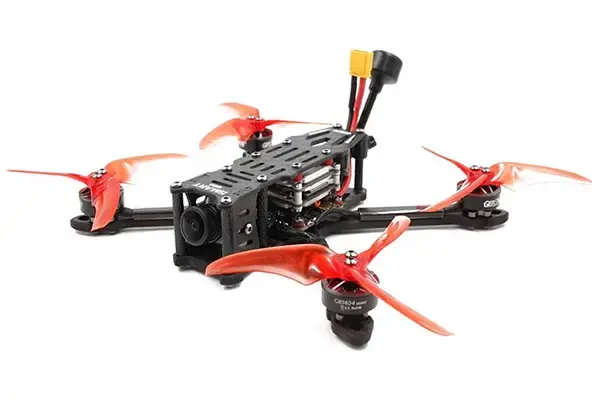
The GEPRC Smart35 was the quad that convinced me that 3.5” was the best all-round prop size for sub-250g freestyle. Its 1404 motors are the standard for 3.5” freestyle under 250g; a larger motor would give better performance, but put the quad over the 250g limit. The frame is simple and robust. A single-piece bottom plate improves durability, but means if you do break an arm, you’ll be replacing the whole thing. One notable feature is that it mounts the Vista video transmitter to the top plate, which avoids putting mass and vibration into the flight control stack, as well as simplifying maintenance. The analog version of the quad comes with a 600 mW video transmitter, which is pretty good for this size category, although more power would always be nice. The flight controller is AIO (all in one) style with integrated 35 amp ESC.
Find this product at these vendors:
EMAX BABYHAWK II HD (3.5”)
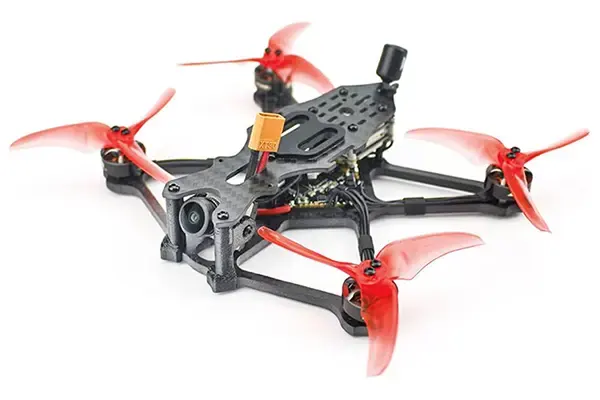
Emax is one of the best, most consistent manufacturers of bind-n-fly quadcopters in all of FPV. Almost every one of their BnF quads is near the top of its category in value, flight performance, capabilities, and durability. The Babyhawk II upholds this reputation. The frame is incredibly durable. The 1404 motors are the standard for 3.5” freestyle under 250g; a larger motor would give better performance, but put the quad over the 250g limit. It comes with an F4 flight controller, which may limit upgradeability in the future, but will perform fine today. The 25 amp ESC is the weak spot in this build, if there is one; we’d prefer to see a little higher rating to increase durability. Recommended battery is an 850 mAh 4S with XT30 connector, which should come in under 100g, putting the entire quad around 240g all up weight.
Find this product at these vendors:
UMMAGAWD 2FIDDY HD (5”)
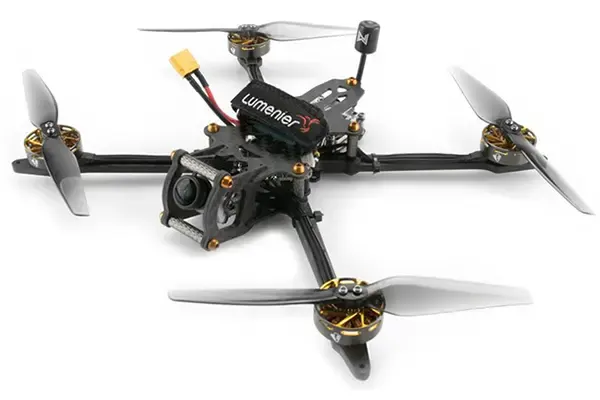
I said everything that I want to say about this quad up in the introduction section of this page. Basically, if you want sub-250g five inch, I think this is one of the only options worth looking at. The 2Fiddy is available with both 6S and 4S motor kv. Tommy prefers the 6S, but this requires a very small 6S battery that basically only Ummagawd sells. If you get the 4S version, performance is still excellent. The bind-n-fly versions are only available with DJI video, but nothing is stopping you from building your own analog version.
Find this product at these vendors:
AVANQUADS AVIO 3
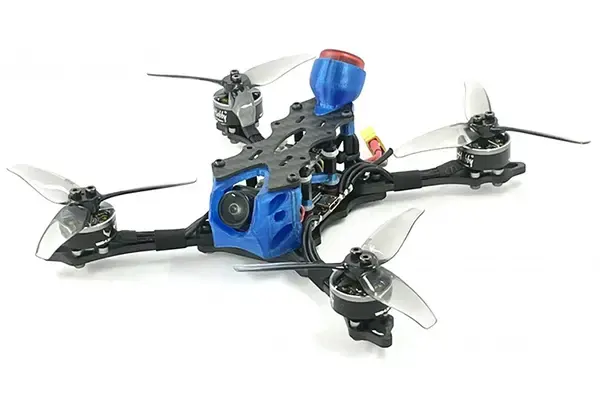
I’ll be honest. I struggled to find a great 3″ bind-n-fly to fit this category. It seems like most of the big manufacturers have switched to 3.5″. Then a commenter on my livestream reminded me of AvantQuads. Even before 250g was a thing, AvantQuads was designing high-performance, lightweight racing and freestyle frames. Even better: they sell bind-n-fly versions!
Although the Avio is a more race-focused frame, I’ve selected it for this category because its raw flight performance is so exceptional. It’s got a bottom-mount battery, which some people say isn’t as good for freestyle. I bet you won’t mind once you fly it.
The beauty of this 3″ quad is that it comes in well under 250g. Its dry weight is about 100g for the analog version and 125g for the DJI version. Add about 100g for the battery and you’ve got enough weight left to run some HD cameras!
Three versions of the quad are linked above. The DJI version speaks for itself. The analog version can be ordered with the Baby Ratel (better, but more expensive) or the Runcam Nano (not as good, but cheaper).
Find this product at these vendors:
Purchase at Avantquads – Analog with Caddx Ratel V2 / HD with Nebula Pro
Sub250 frame design has lagged behind 5” for many years mainly due to a much smaller audience which is where a lot of our R&D comes from. Luckily enough time has now passed for micro’s to catch up and some brilliant frame designers like Ryan Harrell and Ummagawd have brought their years of experience to bear on these lightweight frames. A few of the design elements we take for granted on bigger frames to look for on micros are removable arms so the carbon weave can travel DOWN their length, sensible battery strap mounting provisions, and enough carbon thickness AROUND screw mounting points to prevent a common easy failure point in crashes.
QUADMULA SIREN F3 SPLIT
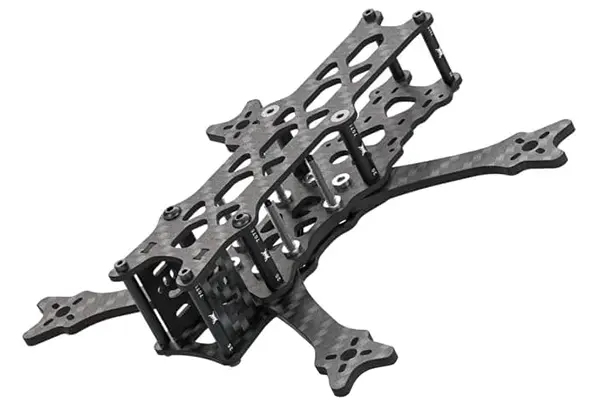
The Siren F3 is one of the newest micro frames on the block and is available with a solid or split baseplate. We prefer the split baseplate design for more strength from the shorter standoffs and slightly less weight. Plenty of room in the rear and camera mounts for 03 Air unit or Vista video systems, and some of the best arm end motor protection available are a few of the highlights but there’s a lot more to love about this frame.
Find this product at these vendors:
QAV-S MINI 3”
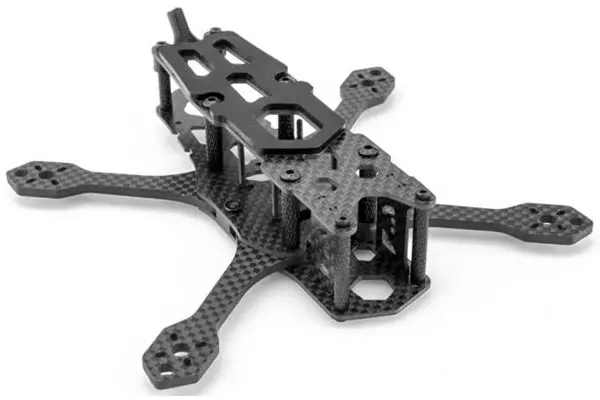
The QAV-S mini 3” is one of the roomier, heavier frames in this category. It’s ideal for a sub-250g 3” build with Caddx Vista, since it has 20mm mounting holes behind the main FC stack. It’s drilled for 25mm AIO toothpick FC, 20mm FC/ESC stack, and 16mm FC/ESC stack, but not 30mm (full size) FC/ESC stack.
If you’re planning to build an analog quad, Ciotti recommends something lighter than the QAV-S mini. The extra size of the QAV-S mini isn’t needed on an analog build, and the extra weight would be better spent on a bigger battery.
Find this product at these vendors:
APEX MICRO 3”
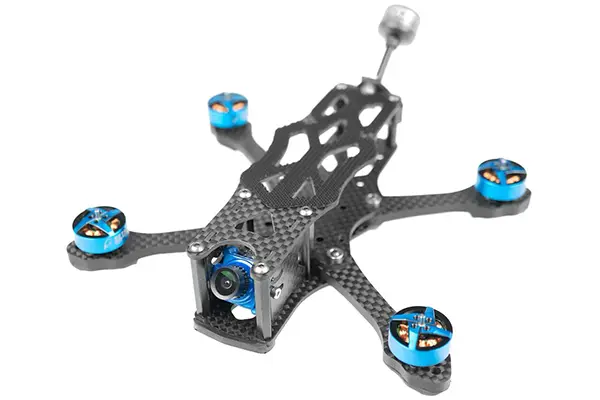
The ImpulseRC Apex Micro 3” is similar in weight to the QAV-S Mini, at 58 grams. So our recommendation is the same: if you’re doing a DJI build and need the extra room to fit a Caddx Vista, consider this frame; but for an analog build, the Apex is overkill.
The Apex has 4mm arms for increased durability, although Ciotti argues this actually puts more stress on the (more expensive and fragile) motors. The thicker arms probably give superior resonance characteristics, although we’re not aware of any tests that verify this. The Apex also has mounting only for 20mm electronics (both front and rear), so those wanting to use 25mm AIO toothpick FC or 16mm stacks will have to look elsewhere.
Like other Apex frames, this one comes with a one year replacement warranty.
Find this product at these vendors:
GEPRC ST35 (3.5”)
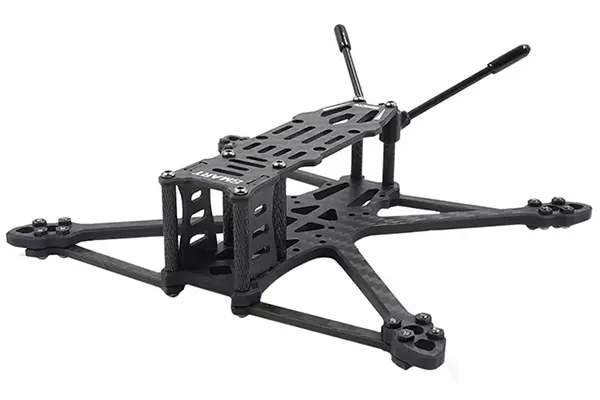
This is the same frame used in the GEPRC Smart35 bind-n-fly, described above. It’s one of the only 3.5” frames available now, so if you want to build one yourself, this may be one of your only choices. It has mounting for 25mm AIO toothpick FC and 20mm FC/ESC stack, but not 16mm FC/ESC or 30mm. One of the most interesting aspects of this frame is that it mounts the Caddx Vista on the top plate. This, when paired with a Toothpick-style AIO FC, gets both the Vista and FC/ESC into a compact frame that doesn’t require rear 20mm mounting holes. Of course, there’s plenty of room for a 3-high FC/ESC/vTX stack if you’re going analog.
Find this product at these vendors:
UMMAGAWD 2FIDDY (5”)
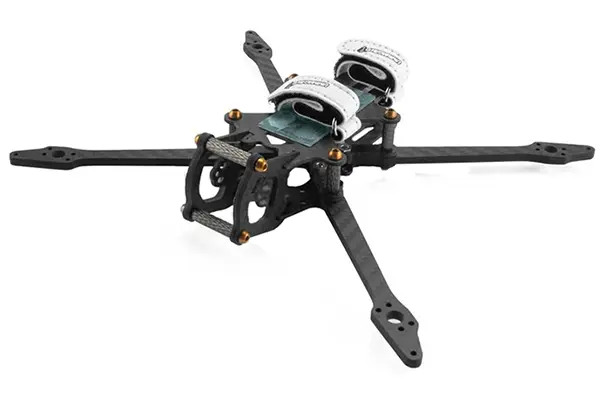
This is the same frame used in the Ummagawd 2Fiddy BnF described above. Keeping this build under 250 grams will require extremely careful parts selection. If you decide to deviate from Tommy’s parts list, be sure to check the weight of your parts. You’ll definitely want to stay with a 25mm AIO toothpick-style FC. Get the highest amp rating you can afford! Tommy builds the 2Fiddy out with DJI, but the 20mm mount in the rear can handle an analog vTX as well.
Find this product at these vendors:
AOS 3.5
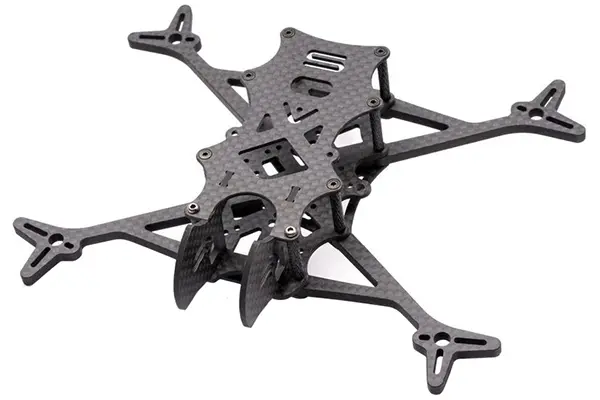
The AOS 3.5 is Chris Rosser’s attempt to make the ultimate frame for sub250 flight. He’s applied his knowledge as an aero thermal engineer to design frames with superior resonance characteristics and durability. This means you can reduce filtering in the flight controller substantially, which results in improved latency and propwash handling. Most 3.5″ frames build out to just barely under 250 grams, but the AOS 3.5’s skillful design means it can be built as light as 225 grams, without compromising durability or flight characteristics. Feel free to use a bigger battery if you like!
Find this product at these vendors:
Choosing motors for a sub-250g build requires a careful balance of weight and performance. Especially as you go to larger prop sizes, you often are forced to choose slightly under-sized motors, which compromises torque and responsiveness. That’s just the tradeoff that the 250g limit forces on you.
Experts differ on whether it’s worth using 6S in this size class. Some motors are not available in 6S kv. If you use 6S and you’re forced to buy a 4S kv for some reason, you can assign a 66% motor output limit in Betaflight to reduce the motor rpm down to safe levels.
FOR 2.5” & LIGHT 3” BUILDS
T-MOTOR
F1404 4600KV
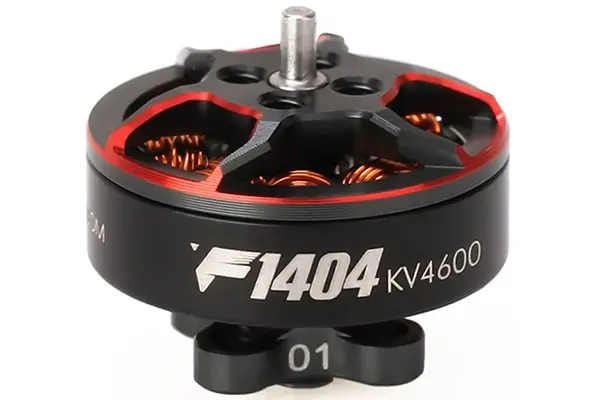
T-Motor’s 1404 is the best all-rounder when it comes to everything we’re looking for in a motor for a 200 – 250 gram AUW micro along with T-Motor’s reputation for great quality products. It has the least motor cogging out of anything else available making it perfect for carrying an HD camera like the Runcam Hybrid, Thumb Pro, or Insta360 Go2 without any jello.
Find this product at these vendors:
AXIS FLYING
AF144 1404 4510KV
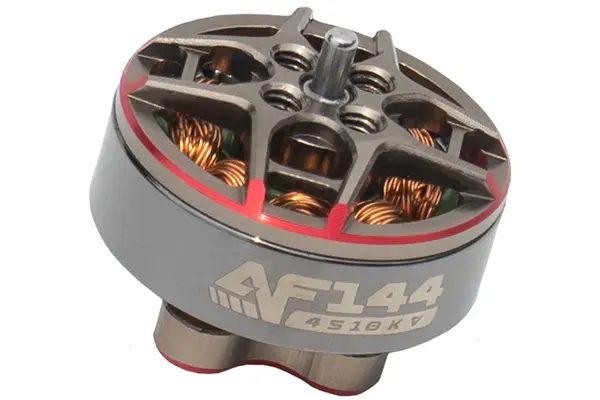
Axis is the new kid on the block but was formed by a few T-Motor employees so it’s no surprise that their motors have been very high quality from day 1. Their 1404 is slightly heavier than the T-Motor but that could mean that they’re a bit more durable, with slightly less kv they will deliver a tiny bit less power but more run time although you could motor limit the T-Motor down to accomplish the same thing.
Find this product at these vendors:
BROTHERHOBBY
TC 1404 4600KV
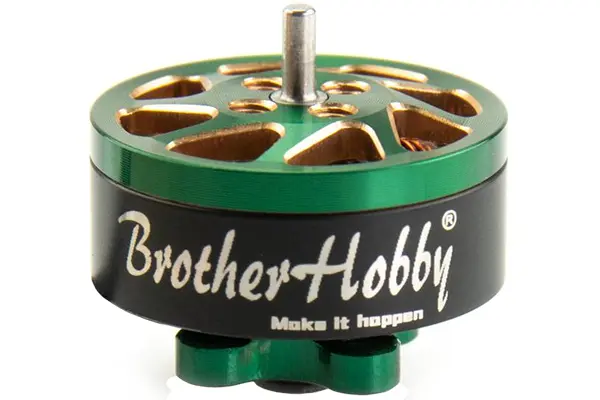
The BrotherHobby 1404 is one of the very few micro motors in existence offering a titanium motor shaft that not only helps it to be the lightest 1404 available but should also make the motor shaft more durable which is the most common failure point on micro motors during hard crashes. Unfortunately, this motor is extremely coggy which is great for power production but not so great if you’re planning on carrying an HD camera (this can cause jello) and can also make tuning more difficult.
Find this product at these vendors:
FOR 3.5” & LIGHT 4” BUILDS
T-MOTOR P1604
2850KV / 3800KV
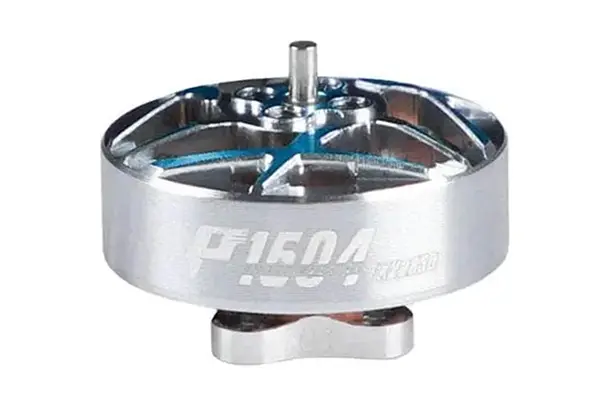
The T-Motor 1604 is the absolute most motor you can get with a 9×9 stator mount base which is great news for everyone running frames that are not dual 9×9/12×12 drilled. This stator volume will match up well with any 3.5” triblade prop, extremely pitchy 3” triblades, any of the 4+ bladed 3” props, or 4” biblades for an ultralight setup. In terms of AUW these motors will shift anywhere from 250 grams to 350 grams with relative ease.
Find this product at these vendors:
XNOVA 1804
2400KV / 3100KV / 3500KV
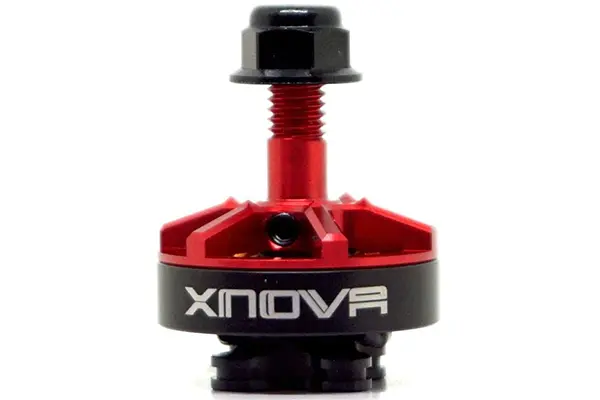
XNova is known for producing incredibly high quality motors so it comes as no surprise that their 1804 is arguably the best micro motor ever made. Incredible durability from a 3mm motor shaft down below the motor bell, ultra smooth power delivery with practically no cogging, and it’s sold with t-mount or M5 prop mount options. This stator size is a great match with AUW’s anywhere from 280 to 400 grams for freestyle and up to 500 grams for cinewhoops or long range builds. For props, extremely pitchy 3” triblades like the T-Motor 3140 will work well or lighter 4/5/6 bladed options, any of the 3.5” triblades, or low pitch/light 4” props.
Find this product at these vendors:
T-MOTOR PACER P1804
2400KV / 3400KV
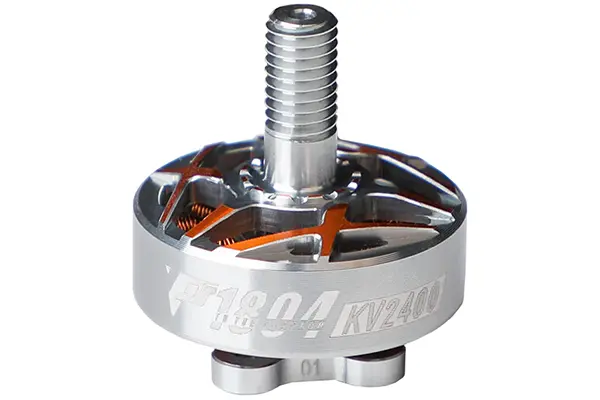
Finally we’ve got another option in the 1804 stator size and luckily it’s from T-Motor who is well known to make very high quality motors. Best suited for lighter 3” 4/5/6 bladed options, any of the 3.5” triblades, or low pitch/light 4” props. These will pair well with builds at AUW’s anywhere from 280 to 400 grams for freestyle and up to 500 grams for cinewhoops or long range builds. Also offered in either M5 or t-mount, another bonus of this fairly wide stator sizing is that it will stay nice and cool even during heavy throttle use when carrying a heavier payload or just flying fast/hard.
Find this product at these vendors:
FOR 4″ & LIGHT 5″ BUILDS
AXIS FLYING AF204
1810 kv / 2910 kv / 3710 kv
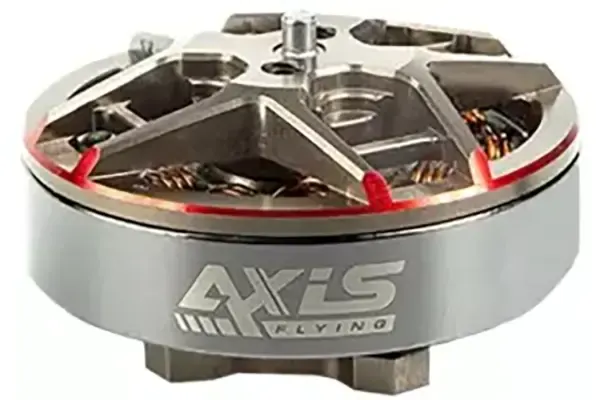
Axis Flying was founded by some employees of T-Motor who broke off to form their own company. With a pedigree like that, you’d expect Axis motors to be the best! The company is still new enough that we can’t say for sure whether they deserve the premium prices they ask for their motors. But they sure look good on paper, if you’re willing to take a chance.
The Axis 2004 motor comes in slightly lower kv for this class. The 4S motor is 2910 kv, and the 6S motor is 1810 kv. As a result, these motors will make a bit less power than their higher rpm alternatives, but flight time will be a little longer.
Find this product at these vendors:
UMMAGAWD AEROLIGHT 2004
2400KV (4S) / 1600KV (6S)
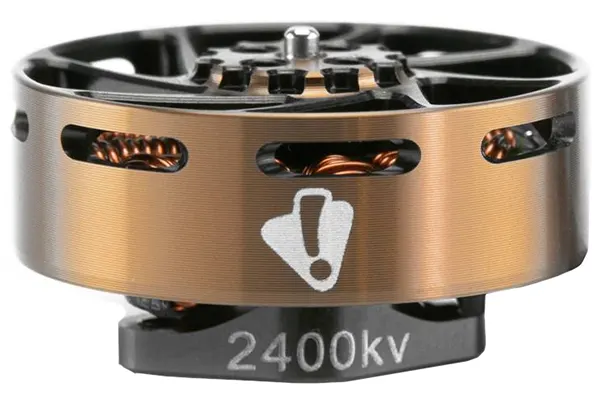
Tommy Tibajia developed this motor specifically for use with the 2Fiddy with a 2-screw base and the motor wires exiting in the same direction as those screw holes. This matches the centralized set of screw holes in the arms of the 2Fiddy for the cleanest motor mounting around also saving weight. Speaking of weight savings, this motor was meticulously designed to be as light as possible but keep in mind that with less weight comes less durability which is especially true in this case.
Find this product at these vendors:
NEWBEEDRONE FLOW 2004
1750 kv / 2000 kv / 2450 kv / 3100 kv
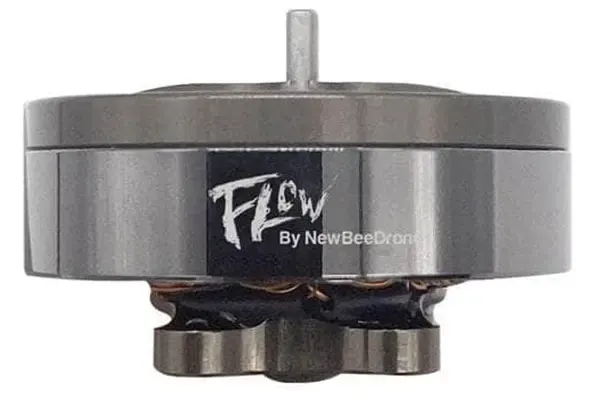
The NewbeeDrone Flow line has always offered great quality and performance for a mid-tier price.
There’s another great thing about the Flow motors: they’re available in 4-packs for a discount, if you know you’re going to need spares (and obviously, you’re going to need spares).
For use with a 4S battery, choose the 3100kv version. The 2000 kv is perfect for a 6S battery.
The 1750 kv and the 2450 kv are actually intended for sub-250g builds running 5″ props, so they’re not ideal for this category. But if you wanted to give up some power in exchange for longer flight time, you might use the 1750kv on 6S with a 4″ prop. And the 2450 kv might do the same thing if you were using 4S batteries.
Find this product at these vendors:
Two sizes of flight controller and ESC are commonly used in this class. With a 20mm FC and ESC, there will be two separate boards, stacked on top of each other with spacers. The advantage of this style is that if the ESC or FC dies, you can replace just that component. The disadvantage of this style is that it takes up more space in the frame.
The 2nd type is a 25mm all-in-one (AIO) FC and ESC. This is also known as a “toothpick” FC, because it was first used in toothpick-style quads. This style combines the FC and ESC into a single board. A 25mm toothpick AIO takes up less space in the build and may be lighter. The disadvantage is that they are often more expensive and less durable than separate FC/ESC stacks. And if any part of it breaks, you’re replacing the whole thing.
You may also hear about 16 mm-sized FC/ESC stacks. These are even smaller and lighter, but we don’t recommend them for this category because they aren’t as durable.
When selecting an FC/ESC combo, make sure that the frame you intend to use is able to mount the size of FC/ESC that you’re getting. Some frames aren’t drilled for 25mm AIO toothpick FC. Also, make sure your ESC amp rating is sufficient. For 3” and 3.5” props, we suggest a minimum of 30 amps (but more is better). For the 2Fiddy, Tommy recommends a 45 amp ESC. Bear in mind that a 20mm or 25mm ESC rated for 50 amps is not going to have the same durability as a 50 amp ESC used on a larger quad, so don’t be afraid to get an ESC with a larger amp rating if you can.
Flight controllers on this page may be marked as “DJI Ready” and “DJI Only”. DJI Ready means that the FC has a plug to allow easy connection of a DJI Air Unit or Caddx Vista. DJI Ready FC’s can still be used with analog FPV systems. DJI Only means that the FC does not support analog video at all, and should only be used with the DJI System. Any FC not marked this way will support both analog and DJI, but if using DJI you’ll need to solder wires to the FC since it doesn’t have a plug.
If you use Walksnail or HDZero vTX, they also work with all of these FC. Instead of having a plug ready to go, you might need to solder some wires to the FC.
HOBBYWING & XROTOR STACK
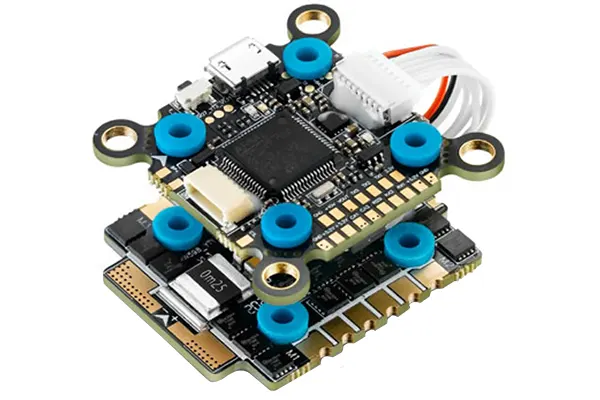
https://www.hobbywingdirect.com/products/combo-xrotor-stack-4in1-esc-fc?variant=39376594403443
The Hobbywing Xrotor Stack has become the standard for open-class FPV racing. Hobbywing has long been known for their excellent ESC’s. The 20mm FC comes with a plug that makes installation of the HDZero video transmitter easy. The FC has a dedicated 12v voltage regulator, which is nice if you’ve got an older video transmitter that doesn’t work from 5v. After the installation of the receiver and digital vTX, the FC will have one spare UART available if you want to add a GPS or some other type of accessory. It also has a vTX kill-switch to power down your analog vTX during team racing or when working on the quad in the pits.
The Hobbywing stack can be purchased with either a 40A or a 45A ESC. The 40A ESC is a lot cheaper, while the 45A is more durable, but a lot pricier. Most racers today run the 40A. Also, don’t let the fact that the Hobbywing is “only” rated for 40A throw you off. Real-world results speak for themselves, and show that this ESC is more than up to the abuse of top-level racing.
Find this product at these vendors:
IFLIGHT BLITZ AIO
F745 FC / 45A ESC
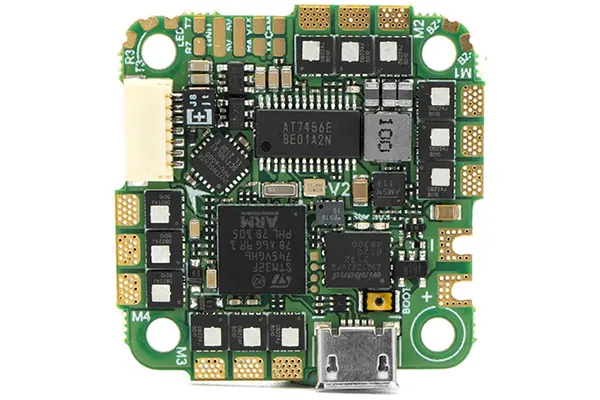
This AIO toothpick-style flight controller has an F745 processor and 55 amp BLHeli_S ESC. Don’t let that 55 amp rating fool you into trying to run it on a big 5″ freestyle build though. It’s still an AIO, and when you put a flight controller and ESC on the same board, you can’t push it as hard as when they’re separate units. The Blitz is still perfect for lighter 3.5″ builds and even ultra-light 5″ builds like the 2fiddy.
Like most iFlight FC, this one has a barometer and can run iNav if you want to do GPS-assisted autonomous flights. Of course, it also runs Betaflight for acro/racing.
The ESC on this combo runs BLHeli_S, so you’ll need to flash BlueJay firmware to it to get the most out of it. (Editor’s note: we have not personally verified that this ESC works with Bluejay. Most of them do. But a few of them don’t. So do your own research.)
The FC has a 5v regulator, but not any 12v or 9v regulator, so if your video transmitter can’t run on 5v, you’ll need to run it off of vBat directly.
Find this product at these vendors:
REDUX32 F4 NANO
50A V2 20X20 ESC
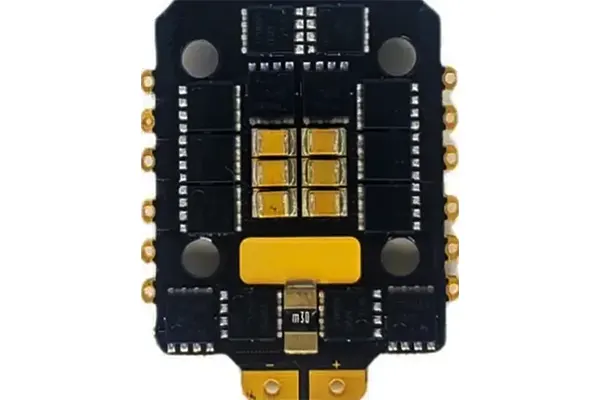
Unlike the other entries, this one is going to start with the ESC, not the FC. Redux Air makes what might be the toughest, highest-performance 20mm ESC available today. It uses the same larger, higher-rated FETs used on 30mm ESC’s. And somehow, they managed to shrink it down from its predecessor so it’s about the same size as other 20mm ESC! In my opinion, this is one of the best 20mm ESC’s you can buy today. If you can find it in stock.
This ESC can be paired with almost any FC, but you will probably have to re-arrange the order of the wires in the harness connecting them together.
Find this product at these vendors:
GEPRC F411
35A ESC
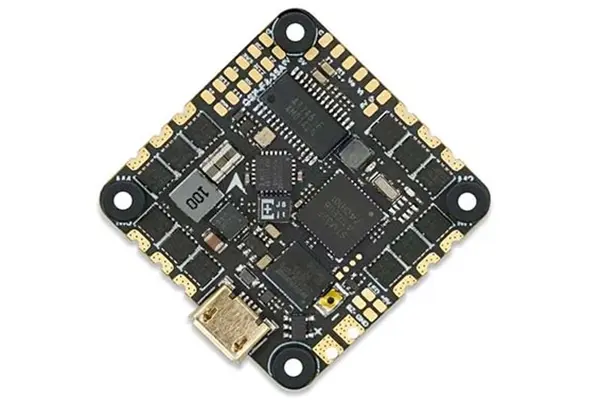
This AIO toothpick-style flight controller is the same one used on the GEPRC Smart35. It’s suitable for use on a 3.5” or 3” build, but nothing larger. With only two available UARTs, you’ll be able to hook up your receiver, your video transmitter or DJI uit, and nothing else. Hope that’s ok
The ESC on this combo runs blheli_s, so you’ll need to flash JESC, JazzMaverick, or BlueJay firmware to it if you want to use bidirectoinal dshot.
This FC has a 5v regulator, for powering your receiver, camera, and a 5v video transmitter. If your video transmitter needs a higher voltage, it must be able to run off your battery voltage, since the FC does not have a 9v or 12v voltage regulator.
est
Find this product at these vendors:
FLYWOO GOKU GN745
W/ 40A BLHELI32 ESC
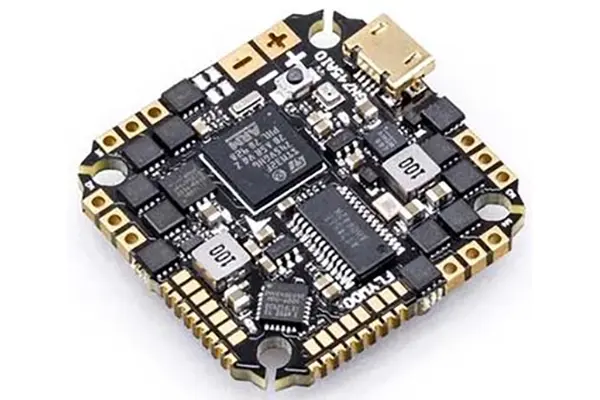
This AIO toothpick-style flight controller sports an F7 processor and a blheli32 ESC, which means it’ll support bidirectional DSHOT and RPM filtering out of the box, as well as other advanced features of blheli32.
How did Flywoo fit seven full UARTs on a board this small? There are a bunch of solder pads right on the edge of the board. This FC will be a little more difficult to solder to than some others, but its feature set is unparalleled! It’s got a barometer on board, a 5v / 2A regulator, and a 9v 1.5A regulator. It’s even got 8 MB of blackbox memory on board!
Find this product at these vendors:
HAKRC
F722 DM MINI HD FC 35A 2-6S ESC
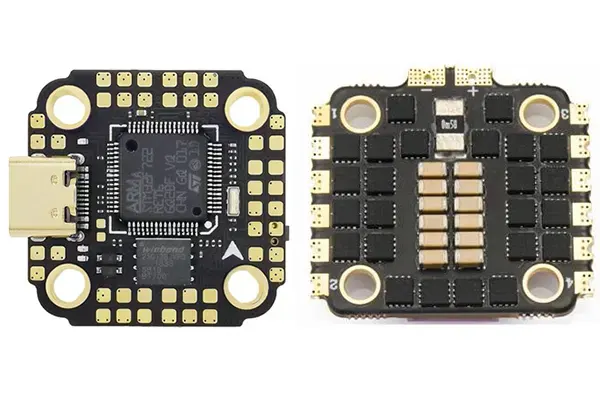
One of the great things about micros is how inexpensive they can be to build since their powertrains are much less demanding, but you need to choose the components carefully since their lower price can also mean less quality control. This will typically show up during hard crashes so the HAKRC FC and ESC’s ability to take plenty of punishment is a HUGE selling point. The Flight Controller has an F7 processor, MPU6000 gyro, and 5 Uarts. Keep in mind that these smaller, lighter, and less expensive ESC’s are not meant to hold up to the demands of big power 2306/2207 5″ rigs, and even though this one is rated up to 6s the lower the voltage you run it on the more durable it will be.
Find this product at these vendors:
Every FPV aircraft has a camera and a video transmitter to send the camera feedback to the pilot. Which camera and video transmitter you choose depends on which video system you’re using. Video systems are divided into two categories–digital and analog–and we have a page with recommendations for both.
If you’re using a digital video system (DJI, Walksnail, or HDZero), CLICK HERE.
If you’re using an analog video system for freestyle or cruising, CLICK HERE.
It’s easy to forget how important a good analog camera is because of the low quality image we receive in our goggles compared to digital systems, but it really does make a big difference. Every gram counts with these lightweight builds so if performance is the highest priority an ultra lightweight nano option will probably be best but for better image quality the micro cams have much bigger lenses and in some cases bigger sensors as well. If you’re looking for HD footage but don’t want to carry a pricey/fragile Insta360 Go 2 or Naked GoPro, the Runcam Hybrid is an incredible option here if you have 30mm of build height
RUNCAM HYBRID 2
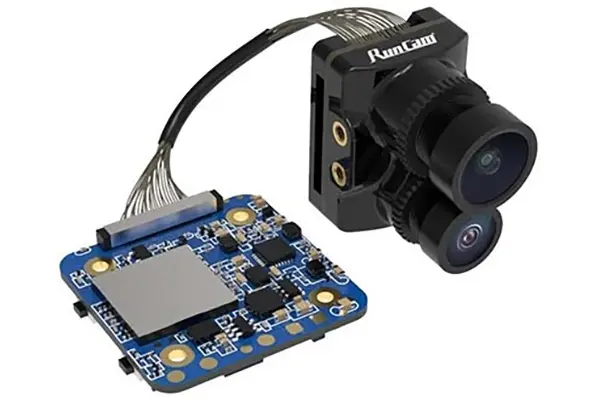
The Runcam Hybrid combines a low-latency analog FPV camera and a 4k HD camera into one unit. The analog signal is sent to the vTX while the 4k HD video is recorded to an SD card on board the quadcopter.
If you are looking to record HD video on a sub-250g quad, your options are extremely limited. This is the most compact, lightest way of recording HD video on a quadcopter.
The tradeoff is image quality. You won’t mistake the Hybrid’s video for a GoPro. Ciotti uses these on his sub-250g 3” builds and the best he can say is that the image is “shockingly decent”. The weakest aspect of the camera’s image is its exposure algorithm, which is “all over the place” as the quad flies from dark to light areas. Ciotti also says this is the first split-style camera that has taken crashes without immediately exploding.
The Hybrid uses 20mm mounting, so you’ll probably need a frame with rear 20mm mounting holes, or a tall frame that can take a 3-high stack of 20mm FC, ESC, and Hybrid. If you’re trying to stay under 250g while including the Hybrid in your build, you’ll probably need to stick to 3” props and frames, although anything is possible if you try hard enough).
Find this product at these vendors:
FOXEER TOOTHLESS 2 NANO STARLIGHT
ANALOG CAMERA
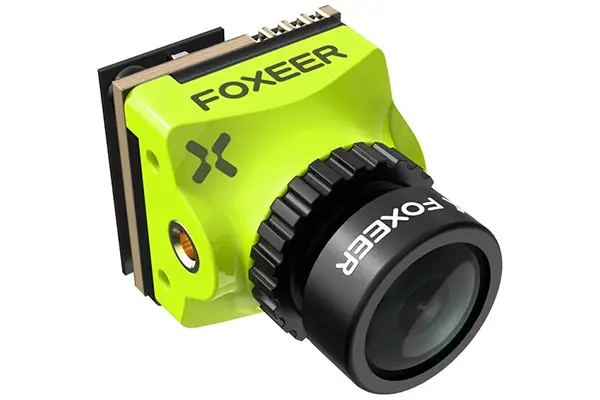
This camera was added to the list after a livestream question asking for a great night-time camera. Ciotti recommended the Toothless Nano Starlight as performing well in both day and night time and said he uses it on all his micro builds. As far as I’m concerned, that should put it near the top of anybody’s list. One note: this is a “nano” sized camera, meaning it’s 14mm wide. Most frames in this category are sized for a “micro” sized camera (19mm wide) and will need an adapter to hold this camera. Fortunately, the Toothless comes with a bracket to adapt it to 19mm.
Find this product at these vendors:
RUNCAM PHOENIX 2
JB EDITION ANALOG CAMERA
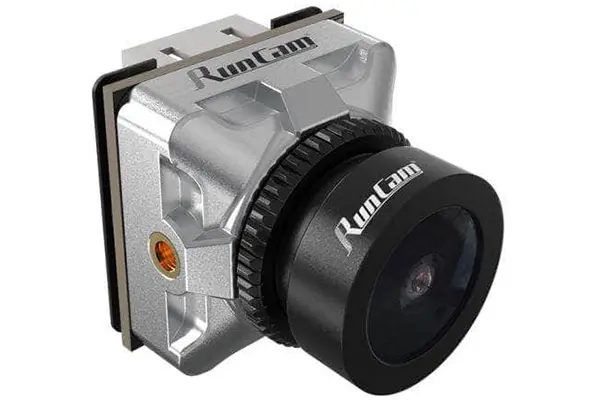
MY PERSONAL FAVORITE
I believe that an FPV camera’s job is to communicate information to the pilot so that they can fly better. That means the best image for FPV is not always the one that looks the best to spectators. I worked with Runcam to customize the Phoenix 2 to deliver the things I look for in an FPV camera.
The contrast and brightness on the JB Phoenix 2 have been tweaked to maximize dynamic range, so you see details in shadow and highlight. Sharpening has been lowered to reduce haloing and shimmer. Finally, I asked Runcam to add digital camera control capability, so you can tweak the camera settings using your flight controller, instead of having to carry a camera joystick with you to the field.
The only way to truly know if this camera is best for you is to take a look at the image in my review.
Find this product at these vendors:
FOXEER T-REX MICRO
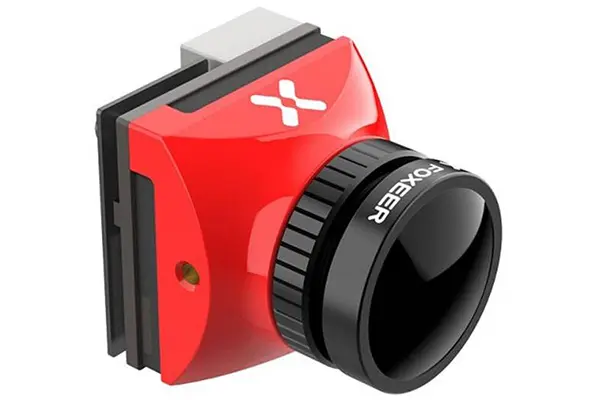
The Foxeer T-Rex boasts the highest resolution sensor of any FPV camera I know, at 1500 tvl. When I first heard this, I wondered whether it was just marketing hype. After all, an SD video feed only has so much resolution, so can you really tell the difference if the camera has higher resolution? After trying the camera out, I think the answer is yes. The difference is small, but there. The T-Rex should be the choice of somebody who wants the absolute most detail you can get from an analog FPV feed.
If you pick up this camera, be aware the input voltage only goes up to 16v, so be careful you don’t feed it from excess voltage and fry it.
Find this product at these vendors:
CADDX BABY RATEL 2 NANO
ANALOG CAMERA
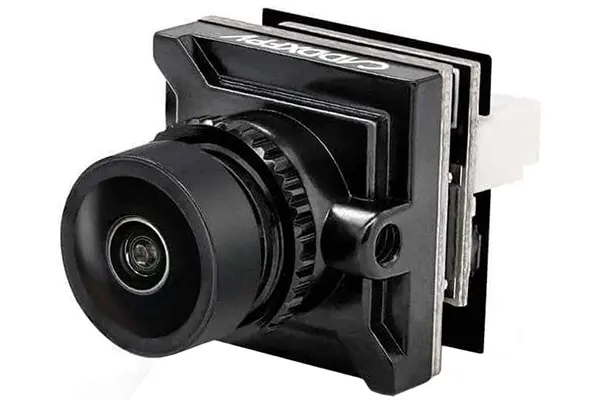
The Caddx Baby Ratel 2 is our pick for best budget analog FPV camera. It’s significantly less expensive than some of the other options, with good image quality and low latency.
Find this product at these vendors:
Selecting a battery for the sub-250g freestyle category is complicated by the strict weight limit. The lighter you build your quad, the more weight you can afford to spend on battery; and the heavier the quad, the smaller and lighter the battery must be. We’ll recommend batteries that work for typical builds.
When shopping for packs in this size/weight range, pay close attention to whether the pack is labeled as HV (high voltage) or not. An HV battery is charged to 4.35 volts, not 4.2 volts. This means you get more mAh than a standard LiPo of similar size. But you can’t just cram more voltage into a tiny cell and expect it to perform as well as a larger cell! HV packs don’t perform as well as their increased mAh would suggest. So if you see a 650 mAh pack that looks suspiciously small, check whether it’s marked as HV, and most likely just pass it up if so. There are some situations where super-light HV packs are the right choice. Just not this category.
C rating of these packs ranges from about 70C at the “budget” end to about 95C at the “premium” end. You’ll pay about 1/3 more for the “premium” ones but especially when packs are this small, the higher C rating will probably be noticeable. That being said, the “budget” ones are just fine.
For 3.5″ builds, a 4S 850 mAh battery weighing about 100-150g is just about as big as you can get while still staying under the 250g limit. For a 3″ build, in theory, you could use a heavier battery and still be under the weight limit, but 3″ props will make less thrust, so the heavier battery will make the quad fly worse. In other words, these are also great packs for 3″ props.
4S FOR 3″ AND 3.5″
RDQ 4S 850 mAh 75C
GNB 4S 850 mAh 80C
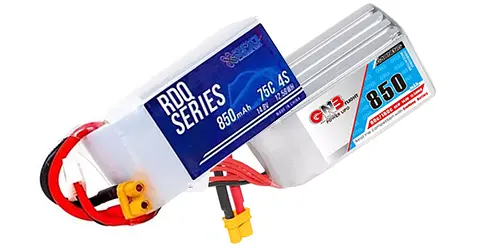
The GNB 4s 850 is the most widely available rock solid performing micro battery with low internal resistance and fantastic durability. Available with XT30 or XT60 connectors and enough power for 3” – 4” freestyle builds all the way up to lightweight 3” cinewhoops.
Find this product at these vendors:
CNHL 4S
850 mAh 70C
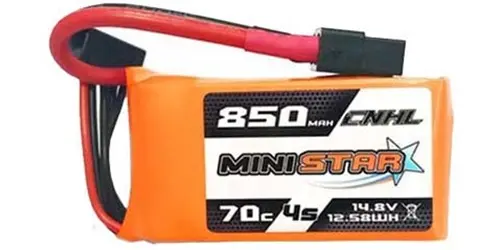
In typical CNHL fashion, their 4s 850mah is slightly less expensive but also slightly heavier than the GNB making it a great option for freestyle bashing where batteries take a ton of punishment.
Find this product at these vendors:
TATTU R-LINE 4S
850 mAh 95C
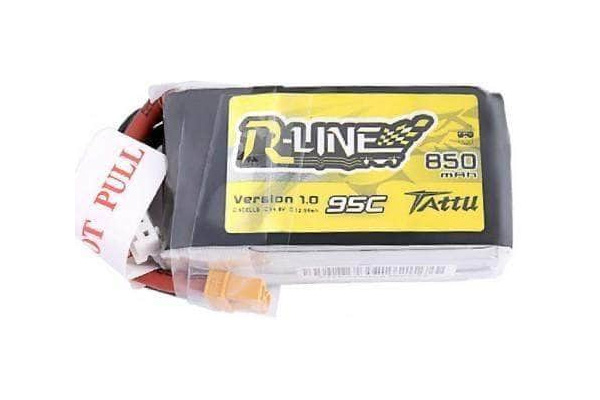
As with most Tattu R-Line batteries, their 4s 850 will offer the best performance but at a slightly higher price point. The older “Version 1” is offered with both XT30 or XT60 but the brand new “Version 4” is only available in XT60 at the moment.
Find this product at these vendors:
TATTU R-LINE 1.0 4S
550 mAh 95C – XT-30
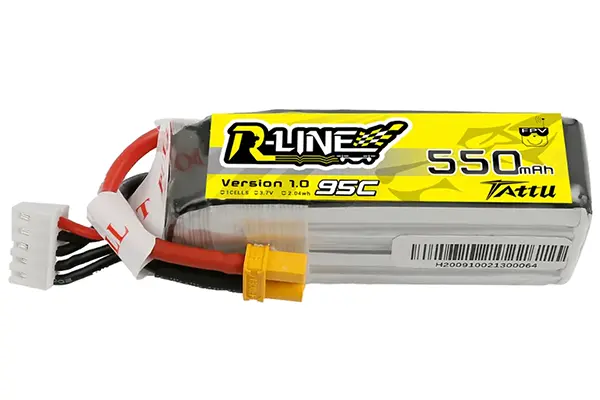
For those ultralight builds you’ll want an ultralight battery and coming in at 46 grams this Tattu R-Line 550 is a great choice. I wouldn’t pair this with motors any larger than 1404 and just keep that AUW down as low as possible.
Find this product at these vendors:
CNHL MINISTAR 4S
650 mAh 70C
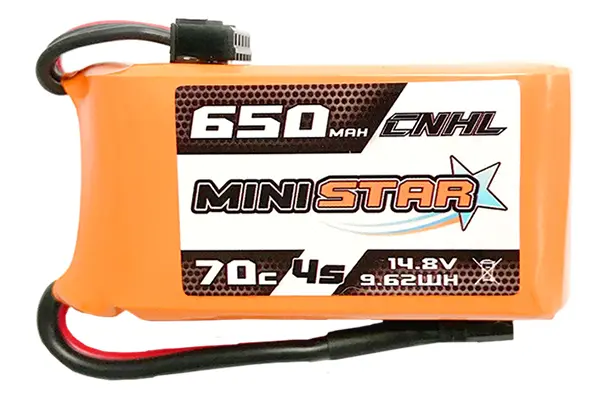
For mid-weight builds that are going to be “sent” hard, this CNHL 4s 650 is a great inexpensive option and performs just as well as any of the more expensive batteries as an airbag to cushion inverted crashes. At 87 grams it’s not much lighter than the 4s 850’s but at $5 less if you’re buying/destroying a bunch the savings will certainly add up.
Find this product at these vendors:
FOR THE 2FIDDY
The Ummagawd 2Fiddy has a very limited selection of batteries. Tommy strongly prefers a 6S build, using the GNB 6S 380 mAh HV. Earlier in the page, we wrote that we’re not convinced there is much advantage to 6S in this category, but obviously Ummagawd disagrees. We also said that HV packs should usually be avoided, except in special cases. This is one of those cases. The 2Fiddy itself weighs about 180-185 grams, which leaves about 65 grams for the battery. At that point, the only way to get decent flight times is to make the packs HV.
GNB 4S HV
650 mAh 60C
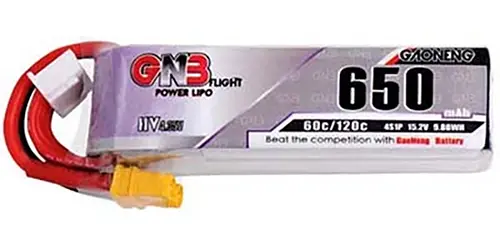
For higher kv motors (like Ummagawd’s 2004 3,500) this 4s 650 will keep your AUW extremely low but still deliver great power. The lower voltage will be more gentle on your electronics and these higher mAh cells tend to sag less offsetting the lower voltage.
Find this product at these vendors:
GNB 6S
380 mAh 90C
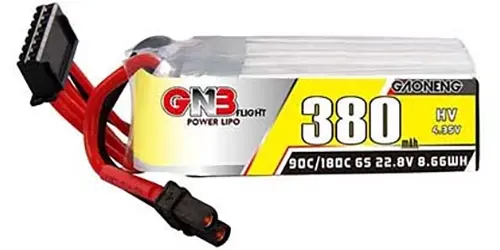
Ummagawd worked really hard with GnB on this battery to get the performance and weight just right, the end result being the best of all worlds on his 2Fiddy build, sub250, 6s, with great run time and power. You’ll want to pair this with his lower kv motors (1600kv for 5” or 2400kv for 4”)
Find this product at these vendors:
6S FOR 3″ AND 3.5″
In this size category, we’re not convinced that 6S batteries give much performance advantage, and if you go up in voltage you have to use smaller cell sizes to keep the overall pack weight where it needs to be. Smaller cells perform worse than larger ones in terms of sag and reliability, an effect that accelerates as you get down to this size but the higher voltage does improve battery sag performance so you may not notice a difference there. Most manufacturers jumped on the 6s hype train years ago, so the main advantage to these batteries is a larger selection of motors. Frankly, we feel 4S is the better choice, but if you decide to go with 6S, here are some choices.
GNB 6S
550 mAh 80C
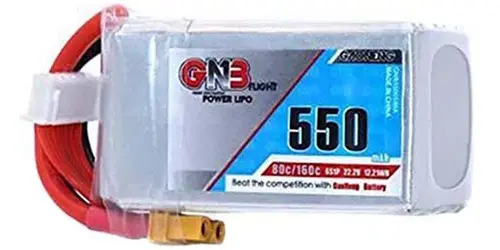
At around 100 grams this is the closest equivalent to the venerable 4s 850 and the 550mAh cell size is just big enough to provide nice even performance all the way down to 3.5v per cell.
Find this product at these vendors:
TATTU R-LINE 6S
650 mAh 95C
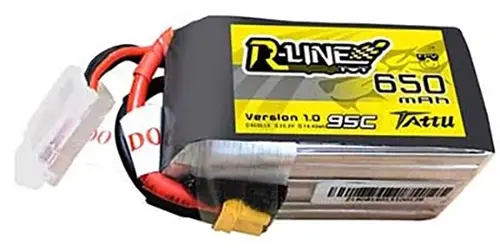
With a higher c rating than its GnB counterpart this Tattu R-Line will deliver slightly more power but at the cost of slightly less reliability/longevity.
Find this product at these vendors:
RDQ 6S
650 mAh 70C
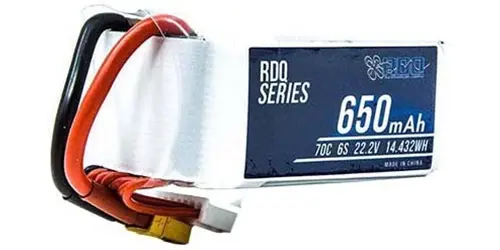
If you can carry a bit of extra weight over the 6s 550, these 650mAh cells will perform significantly better even though it has a slightly lower c rating.
Find this product at these vendors:
FOR 3” BUILDS
While there is much less of a selection and variety with micro props compared to 5” there are some diamonds in the rough that perform incredibly well. Most micro motors are t-mount but for the rare M5 mount motor, all of the Gemfan props have a hub that will work with either design.
GEMFAN FLASH
3052-3
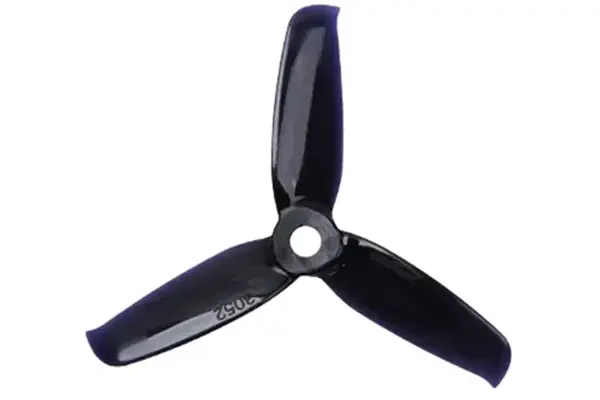
If you’re looking for speed there’s nothing that can match Gemfan’s 3052. With a pitch of 3.5” and a blade designed to properly manage tip vortices you’ll get incredible power AND efficiency but make sure you have enough stator volume so you’re not overpropped, you’ll want 1404’s at a bare minimum.
Find this product at these vendors:
DAL CYCLONE
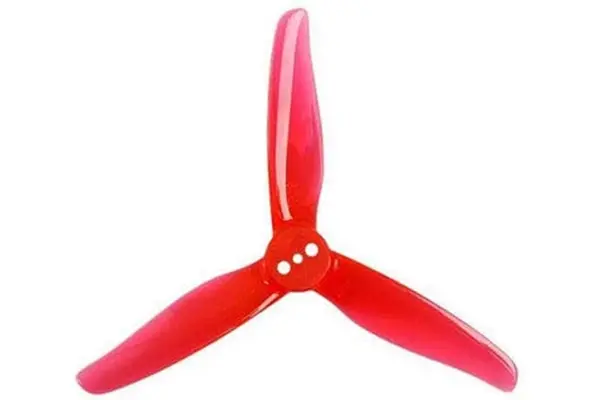
For 250ish gram 3” freestyle builds the Dal Cyclone 3028 is truly magic, 1404’s are the most popular motor option and they match up beautifully with these props. The blade profile is very similar to modern 5” props as is the performance with great durability and plenty of power. The 3018 variant is a good option for either lighter weight sub-200-gram builds or extremely high kv motors.
Find this product at these vendors:
HQPROP
T3X2.5X3
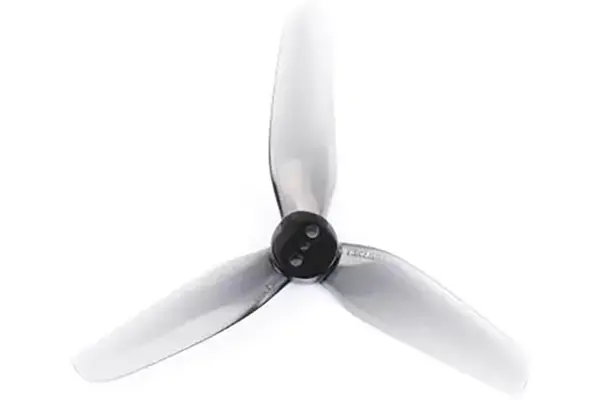
This HQ 3×2.5 has a great balance of pitch, durability, and weight making it a strong contender for the best 3” freestyle prop. The grey color is one of our favorite aspects since with many micro builds you’re using the FPV camera for your HD footage and most frames have at least some prop in view.
Find this product at these vendors:
FOR 3.5” BUILDS
GEMFAN HURRICANE 3520
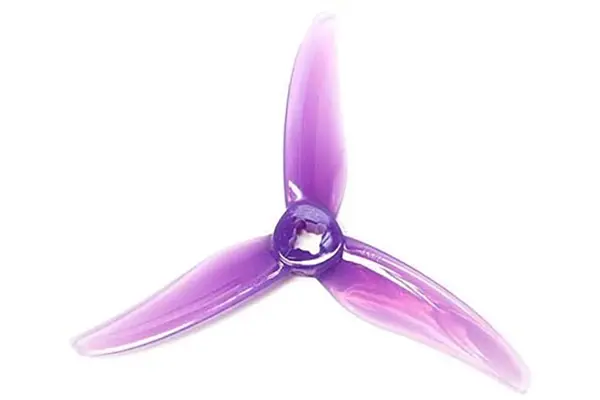
These were one of the first 3.5” prop options and are still one of the best, with lower pitch than the HQ and Emax these will spin up faster while still providing great thrust. These are also the only option that will work on M5 mount motors.
Find this product at these vendors:
HQPROP
T3.5X2.5X3
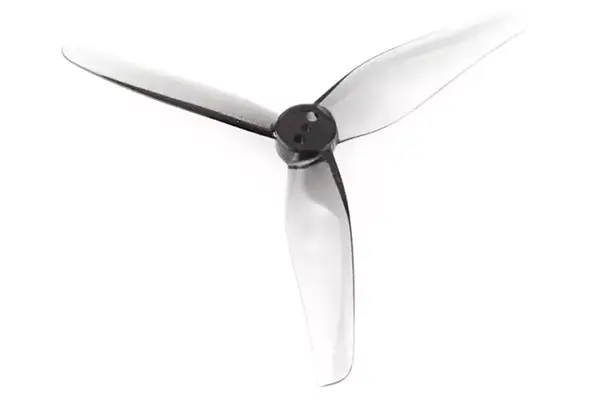
For t-mount motors, these HQ’s have a great modern blade profile and balance of durability, power, and efficiency. The grey color practically disappears on frames with props in view which is ideal for freestyle builds.
Find this product at these vendors:
EMAX SCIMITAR 3.5″
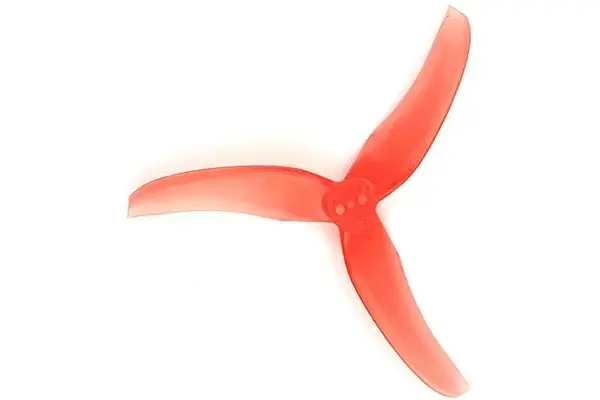
While only available in red, these Emax Scimitars are the best-performing 3.5” tri-blades but there’s a catch. The ultra-aggressive blade profile swoops down below the mount base of the hub meaning that these will not work on motors where the top of the bell is completely flat, you’ll need a bell with raised mounting surface.
Find this product at these vendors:
FOR 5” 2FIDDY BUILDS
HQ T5x3x2
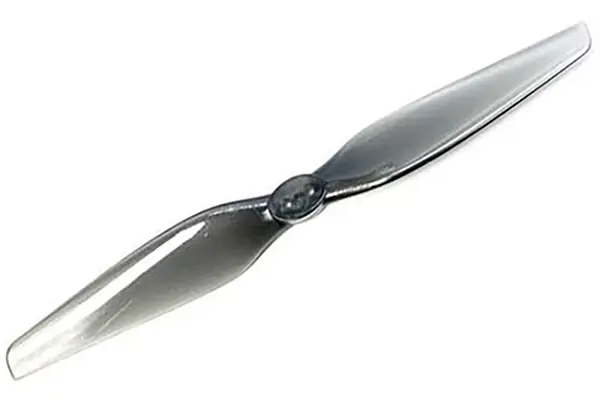
Find this product at these vendors:


